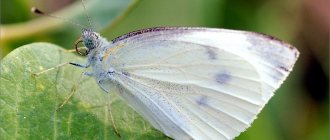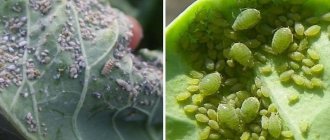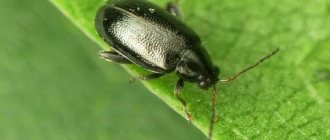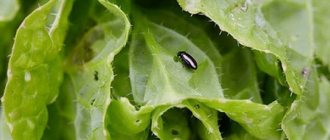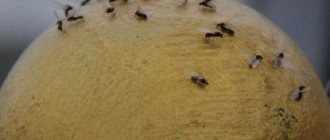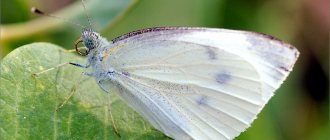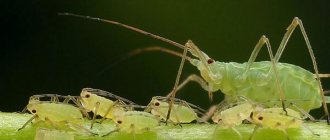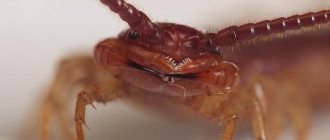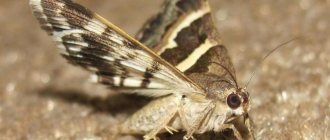Among the parasites that attack cabbage, the butterfly poses a serious danger. It is found throughout Russia and causes enormous damage to cabbage plantations. If an insect appears in the garden, it must be destroyed immediately.
Folk remedies are very effective against pests - they can always be found in the house and are cheap. Advice from experienced gardeners will tell you how to fight butterflies on cabbage using folk remedies.
Who is she - the storm of vegetable gardens?
Some novice summer residents do not know what cabbage looks like, but you need to know the enemy by sight.
Then it will be clear who the fight will be with. The second name of this pest is cabbage white. Indeed, this butterfly has light wings, but they have minor black inclusions. Females have a more pronounced dark pattern on their wings and are larger than their partners. Female representatives of this species have a forewing length of 27-33 mm, and males - 25-30 mm.
Of course, they lay eggs, from which voracious female caterpillars then hatch. Therefore, representatives of this sex are the most dangerous for crops.
One female can lay up to 300 lemon-yellow eggs. The clutches are located on the back of the leaves. After 3-16 days, voracious caterpillars hatch, quickly increase in size and begin their destructive activities.
Description of the species
Belongs to the whitefish family. It got its name because it prefers to eat cruciferous plants, in particular cabbage.
You can recognize a butterfly by the following parameters:
- Body structure. Has 4 wings and a dark body.
- Color. Mostly white. Females have black spots on their wings.
- Wingspan. Reaches 6 cm in females. In males this figure is lower.
- Larvae. Stay in groups, have ocher-colored bodies.
- Caterpillars. They can be distinguished by their greenish color. White stripes are visible on the body, which are located along the entire body of the pest. The size of the pests is 2-3 cm.
What plants does he like?
Although this butterfly is called that, it loves to feast on more than just cabbage.
Here are the plants that the whiteweed affects:
- horseradish;
- rutabaga;
- gray hiccup;
- shepherd's purse;
- radish;
- capers;
- turnip;
- garden and field cabbage;
- turnip;
- dyeing weed;
- some types of flowers.
Plants are pestered by voracious caterpillars, which in a short time can eat most of the leaves. Butterflies are harmful only because they lay numerous offspring. There are also benefits in whites. Fluttering from flower to flower, cabbage carries pollen, thereby pollinating plants.
But it is necessary to implement timely measures to combat this pest. These methods can be:
- mechanical;
- folk;
- attracting beneficial insects;
- in the form of life hacks;
- chemical.
Cabbage butterfly - harm
It is necessary to distinguish between what cabbage butterflies and their numerous offspring eat. Caterpillars eat all types of cabbage, horseradish, rutabaga and radish, turnips with turnips, and field plants of the cruciferous family. The butterfly itself is harmless and pollinates flowers; it does not pose an immediate danger to garden crops. It is advisable to carry out preventive work to destroy cabbage grass at all stages of its development.
Cabbage butterfly on cabbage
Our insect is a highly specialized creature that exclusively loves cabbage crops. It lays its eggs on the underside of the leaf blade, hiding them from birds and people. The caterpillars are green in color, blending well with the cabbage leaves. Gradually, they devour leaves from the edges to the rough-textured skeletal veins. In large numbers, pests completely eat the entire head of the plant. In the question of how to protect cabbage from the cabbage butterfly, you can use both folk and chemical methods.
Cabbage butterflies on raspberries
Our heroine can be found both in the garden and on various trees or bushes. Cabbage butterflies often land on raspberries; what should a gardener who is worried about his plantings do in this case? You don’t have to worry, this insect does not threaten raspberries with their hard leaves. Sometimes the hawthorn butterfly is mistaken for it, which comes from the common white butterfly family and has similar sizes and wing colors. This pest seriously affects fruit and berry crops located in the vicinity of raspberries.
Mechanical methods of control
One cabbage butterfly is capable of breeding 2-3 generations of caterpillars per season. With the onset of warm spring days, you can already see white moths flying. At the beginning of summer, caterpillars hatch from the laid eggs, which then grow into butterflies. They will give rise to another generation of pests.
The caterpillars that pupate at the end of summer - beginning of autumn overwinter in the cracks of buildings and houses. They may also be located under the bark. To prevent pests from overwintering here, farmers whiten trees at the end of autumn. At the same time you need to inspect the bark. If you notice cabbage butterfly pupae here, you need to remove and destroy them.
The next mechanical method is used at the beginning of summer. It is necessary to periodically inspect the underside of the leaves, and if a clutch of eggs or caterpillars is found, they are destroyed.
Expert opinion
Mityuk Stefania Bogdanovna
I try not to use “chemicals” in my garden. Previously, I offered children such entertainment - catching cabbage butterflies with nets. And the kids are happy about this activity, and most of the pests were neutralized using this mechanical method.
Preventative work
Experienced gardeners recommend the following preventive measures against whiteweed:
- regularly at the very beginning of the season it is necessary to destroy all weeds in the garden, since butterflies lay eggs on them in early spring;
- perform a daily inspection of the lower part of the leaves, scrupulously collecting all the laid white eggs;
- to reduce the pest population, it is advisable to dig up the garden in the fall;
- before winter you need to carefully check the bark of trees, find and destroy caterpillar pupae;
- It is advisable to plant cabbage seedlings early, while the butterflies are not yet flying en masse;
- You can’t plant cabbage next to mustard, horseradish, and radishes;
- when the bed is small, you can cover it with a plastic mesh that allows the sun's rays to pass through, but does not allow the leaves to come into contact with the butterflies.
Beneficial insects
Some small gardeners are able to help a person cope with cabbage.
Not everyone knows that wasps can be useful to a gardener. These insects feed their young, including cabbage caterpillars. One wasp can carry up to 6 caterpillars to its nest per day.
The ichneumon ichneumon lays eggs in the caterpillar.
Therefore, before destroying a wasp’s nest, think about perhaps placing a cabbage bed nearby, but away from residential buildings.
There are other insect predators that can cope with cabbage offspring. For example, riders lay their eggs in caterpillars or larvae, piercing them with their sting. When the ichneumon ichneumon larva hatches, it will suck all the juices out of the insect it contains.
Therefore, if riders live on your site, do not destroy them, do not poison them with “chemicals”. In appearance, these insects are similar to wasps, but with a more elongated pelvis. Their larvae are oblong and white.
It will also be useful for garden crops if Trichogramma live on the site. These small insects, only 1 mm long, lay their offspring in the eggs of pests. In this way, they can also destroy the whitefish larvae in the bud.
Dangerous cruciferous flea beetle
One of the most dangerous pests for young shoots of cabbage and other crops of this species is the cruciferous flea beetle. It is a small jumping beetle with a body length of about three millimeters.
After winter is over, this pest can be hidden in the surface layer of soil, fallen leaves, greenhouse and greenhouse crevices. The beetles wake up in early spring when the soil settles. First, adult insects eat cabbage weeds, and then begin to eat cabbage vegetables and freshly planted seedlings. They mainly damage young leaves of plants. The beetles gnaw small holes on the leaves, which leads to the leaves drying out and the plant dying.
Control of cabbage pests - cruciferous flea beetles - is especially important in hot spring weather, when there are too many of them. At this time, the pest is capable of destroying absolutely all seedlings of planted seedlings over large areas, since it can eat a volume three times its weight.
Interesting life hacks
Popular thought is not asleep, and such research is supported by famous farmers of the country.
The famous garden designer and TV presenter Olga Platonova advises sticking sticks with washed egg shells on the tops next to the cabbage. Flying over these devices, the cabbage butterfly will think that another of its fellow tribesmen is laying eggs in this area, and will not touch the planting.
What means do you use to combat cabbage?
ChemicalFolk
Reputable gardeners also advise covering slightly grown cabbage with low-density white non-woven material or a mesh with small cells. Then not only the whitefish, but also other pests will not be able to penetrate here. In the same way, you can save cabbage from other pests.
Some lay out boards between the rows of plantings, and when caterpillars crawl under them in the heat, they collect and destroy the pests.
Expert opinion
Mityuk Stefania Bogdanovna
Gardeners also plant next to plants that are annoyed by whites, onions, garlic, and marigolds. The smell of these crops will repel pests, and you will receive additional decorations in the form of flowers, and you will be able to compact the plantings by growing onions and garlic here.
Beauties and Beasts: how to protect cabbage from voracious caterpillars
If no measures are taken, then in just a few weeks the voracious insects will gnaw away the entire garden. The butterflies themselves do not cause any harm to the cabbage, but their larvae - caterpillars - are capable of destroying the entire cabbage plantation. They make holes in the leaves and damage the heads of cabbage, gnawing out entire labyrinths in them.
Which butterflies are malicious pests
There are two types of butterflies that are especially dangerous for cabbage: the cabbage white (also called cabbage moth) and the cabbage cutworm.
The first is a day butterfly with white wings. Their distinctive feature is the tops of the front wings painted black. Elongated oval yellow eggs, from which small caterpillars hatch, are capable of being laid up to three times per season. You should look for them on the underside of the cabbage leaf. If pests are not controlled, they will eat the entire head of cabbage, leaving only thick veins.
Unlike its “colleague,” the cutworm is a nocturnal moth that is attracted to bright light. A characteristic feature is the brown color of the wings, on which a dark pattern may sometimes appear. Cabbage moth eggs are white and round in shape, and the butterfly lays them inside the head of cabbage 2-3 times per season. The damage caused by the caterpillars is approximately the same as that caused by the larvae of cabbage whites: they gnaw passages inside the cabbage, and their waste causes rotting of the cabbage head.
In addition to these two species, cabbage moths and turnips like to feast on cabbage.
How to Prevent Caterpillars
The best way to control insect pests is to keep them out of your garden bed. Often, preventative measures are much better than fighting for the harvest with voracious caterpillars.
As soon as you notice that butterflies begin to appear above the garden bed, your first action should be as follows: cover the beds with fine mesh or the thinnest white covering material. This should be done in May, July and towards the end of summer.
The next method is a kind of military stratagem. Butterflies do not lay eggs in territory occupied by other individuals, because the larvae will then not have enough food. Therefore, some summer residents stretch a string over the garden bed, and tie egg shells strung on a thick thread to it.
Young seedlings can be powdered with ash, but this should only be done in dry weather. This method will help you for just a few days, then you will need to repeat it.
Butterflies can also be repelled by plants that have a strong, tart or spicy scent. Therefore, marigolds, calendula, celery, pyrethrum and nasturtiums can be planted near the beds. Also, butterflies cannot tolerate the smell of potato tops, nettles, and tomatoes. The crushed tops are infused in a small amount of water, filtered and sprayed on the plantings.
Wasps and ants feed their offspring with caterpillars and black worms, so it is very useful to lure them to the cabbage with sweet syrup; they will inspect the cabbage very carefully and help get rid of parasites. It is even worth bringing ants with soil from the nearest anthill; they will eat the parasites and go back (if the anthill is not too far away).
After harvesting, the area must be dug up to a depth of at least 15 cm. This will destroy egg laying and pupae that overwinter in the soil.
Popular
news
Folk remedies for fighting caterpillars
Most often, pests that have already settled on cabbage are fought with solutions of vinegar, salt or ammonia. They are prepared as follows: dilute 2 tablespoons of salt, or 1 glass of vinegar (1 tablespoon of vinegar essence), or 50 g of ammonia in 10 liters of water. Each plant is sprayed with one of the resulting solutions; this procedure is repeated several times during the season. To prolong the effect of these products, add a little liquid or grated laundry soap.
Sprinkle the cabbage with a decoction of hot pepper. To prepare it, boil 1 kg of chopped pepper in 10 liters of water, leave for 2 days, then filter. This solution is diluted before use as follows: 150 ml per 10 liters of water. Another 40 g of soap is added to the resulting liquid. In general, herbal decoctions and herbal infusions are very common in pest control. They are usually made from what grows in the garden and is not poisonous to humans. An infusion is made from dried delphinium leaves (infuse 1 kg of leaves in 10 liters of water for 1 day, then add a little soap), chamomile, and burdock.
What chemicals can you use to treat cabbage?
If all of the above remedies do not help, then it’s the turn of the heavy artillery – chemicals. Chemical remedies should be used with caution. It is better to choose class 4 insecticides
dangers, which include such biological products as “Bitoxibacilin”, “Lepidocid”, “Akarin” and “Fitoverm”. Cabbage should be treated with biological preparations repeatedly; their effect on pests can be seen only a few days after application. If the infestation of caterpillars is too large, then treatment with class 3 pesticides is possible. It must be remembered that it will be possible to harvest only a month after treatment.
It is worth processing cabbage three times per season: in May, July and at the end of August or beginning of September. To accurately determine the processing date, you should monitor the moment when the butterflies appear. It is best to carry out treatment when eggs are found on the leaves or when the caterpillars have just appeared and have not had time to cause serious damage. Foliar feeding of cabbage reduces the number of pests. To do this, dilute 1 teaspoon of potassium chloride and 4 teaspoons of superphosphate in granules in 4 liters of water.
Chemical control agents
If the cabbage butterfly invasion has become widespread, and you have a lot of plantings that need to be protected, then you can use insecticides. But you must act strictly according to the instructions so as not to harm the plants and yourself.
One of the most effective means is “Senpai KE”. It is designed to combat leaf-eating insects at all stages of pest development.
This drug is sold in ampoules. 5 ml of the product are diluted in 5 liters of water, sprayed with this amount of solution 100 sq. m. landing. The effect of the solution will begin to appear after 30-120 minutes. After the destruction of these eggs, caterpillars, cabbage butterflies will fly around the treated area for another two weeks
The drug "Iskra M" is time-tested. It also has a long spectrum of action and fights various pests. To prepare a solution against whites, you need to dilute a 5 ml ampoule in 5 liters of water. This amount of working solution is enough to treat 50 square meters. m. landing.
When using these tools, you need to:
- carry out spraying in calm, dry weather;
- the gardener should wear a protective mask, goggles, and gloves;
- Process for the last time no later than 20 days before harvest.
Biological protection
The safest method of destroying cabbage caterpillars is to attract its natural enemies to the garden bed: insects and birds. If the garden exudes the smell of herbs, ladybugs and beetles will fly to it. They are guaranteed to destroy caterpillars and aphids, leaving the plants intact.
Attracting birds to your garden is an effective way to protect your cabbage from pests. Build birdhouses and feed the birds regularly. Wasps and ants are excellent hunters, feasting on caterpillars. These insects feed their larvae with them. To attract them to the beds, water the cabbage with honey or sugar solution.
Advice! It is recommended to use Bitoxibacillin, a biological agent that protects against whites. It contains exotoxin and bacterial spores. Take 100 g of the substance into a bucket of water and mix thoroughly. To increase the stickiness of the solution, it is advisable to add dry milk (a couple of tablespoons is enough). Apply the prepared suspension to the leaves when the weather is dry. After a week, repeat the treatment. The drug is completely non-toxic.
